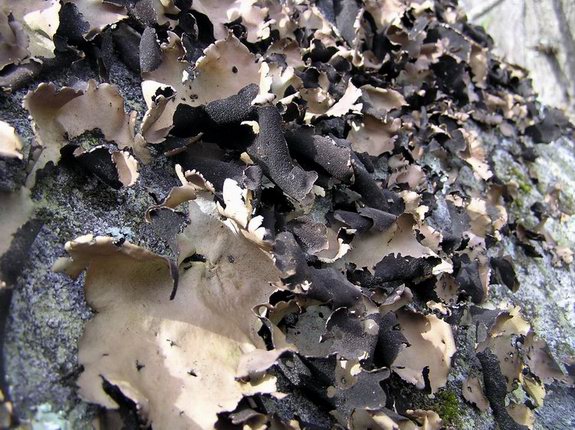|
Return to Hiker's Notebook Home Page
Common Name: Rock Tripe, Navel lichen - The common name is a direct translation of tripe-de-roche, the French name for the lichen. Tripe is the name for the wall of the stomach of a ruminant animal when consumed as a food. It has taken on a number of secondary meanings that generally convey a notion of being worthless or of inferior quality. Thus the common name conveys that it is a poor quality food, like tripe, that is found on rocks.
Scientific Name: Umbilicaria mammulata - The genus is derived from the Latin umbilicus meaning navel (the umbilical cord attachment point); the whorled shape of the lichen with its single attachment point is similar in appearance to a navel - note that the common name navel lichen (used by the USDA) is based on this association. The species name is from the Latin word mammula meaning small breast. This is in reference to the presence of papillae on the lower, black surface of the lichen; a papilla is a small, rounded bump, like goose flesh. The term mammular means covered with papillae. The net result is a lichen that looks like a navel and is covered with small bumps.
Rock tripe is a lichen; a dual organism that consists of a fungus and an alga that live in mutualism, a type of symbiosis in which both constituents share the benefits of the association. A lichen has been called a fungus that has discovered agriculture; the fungus constitutes the bulk of the thallus, or vegetative body, the alga having been incorporated as a source of photosynthetic energy. The close mutual relationship allows lichens to occupy extremely adverse environmental habitats that range from isolated rock outcrops in the frigid rarefied atmosphere at elevations over 6,000 meters; there are over 3,600 species of lichen in North America alone. Rock tripe are among the hardiest of the lichens, they can survive extreme drought for over 62 weeks.
Since the lichens called rock tripe thrive in the harshest arctic climates and maintain their viability through the winter, they have long served as a source of emergency food by Native Americans. The French name tripe-de-roche precedes the translation into the English rock tripe; the provenance of the term is Canadian. The Inuit peoples of the Canadian arctic regions considered rock tripe to be a food of last resort, to be eaten only in times of starvation, its continuous use thought to be pathological. Other Native Americans found it more palatable, incorporating it into their routine regimen of food gathering and preparation. For example the Cree, which constitute the largest group of First Nations (Native Canadians, or in Quebecois, Autochthones), used it as an additive to fish broth to make a thick soup that was not only eaten for nutrition but was considered to be somewhat medicinal, affording nourishment to the sick.
The early explorers of the North America became aware of the use of rock tripe as a survival food from the indigenous peoples, and used it on occasion of isolation to stave off starvation. Most notable was the fist expedition of John Franklin to map out the Northwest passage from Europe to Asia from 1819 to 1822. In the second year of the exploration, the party of 20 was forced to return on foot when their two birch bark canoes became damaged. Franklin's journal recorded the epic journey which has become one of the epitomes of deprivation: "Previous to setting out, the whole party ate the remains of their old shoes, and whatever scraps of leather they had, to strengthen their stomachs for the fatigue of the day's journey �. The tripe-de-roche, even where we got enough, only serving to allay the pangs of hunger for a short time." Nine of the party succumbed to the ordeal. Franklin survived, ultimately to perish with 134 officers and sailors on his two ships, the Erebus and the Terror on his fourth quest for the Northwest passage; they were last seen in July of 1845. The ragged vestiges of Washington's Continental Army are said to have consumed rock tripe to survive the winter at Valley Forge, Pennsylvania in 1777. Ironically, U. esculenta, a rock tripe species indigenous to Asia called Iwatake (literally rock mushroom) is considered a delicacy in modern-day Japan. It is so sought after, that harvesters repel down steep slopes to collect it, favoring wet weather to reduce the risk of crumbling of the delicate lichen.
The nutritional and medicinal value of rock tripe fungi has been investigated experimentally to evaluate its viability as a survival food. A lichen supplementation was given to female mice for three weeks to measure its effects on growth, metabolism and immune function in comparison to a control group fed a standard diet. The lichen-fed mice had a higher growth rate and ate more than the control group. Testing of the vital organs, including the heart, liver, kidneys and spleen revealed the lichen diet had no deleterious effects. The study concluded that rock tripe was not only a good source of nutrition in survival situations but that it acted to stimulate the immune system, as manifest in an increase in the production spleen B-lymphocytes. A second evaluation of several varieties of rock tripe found that they manifested substantive anti-bacterial activity against most of the bacteria tested. Rock tripe is used as a medicine in China. |
